How to Make Your Desk Setup Feel Less Like... a Desk
Why Your Desk Feels Like a Workspace
Working from home sounds great—until you find yourself glued to a stiff chair at a generic desk, surrounded by cold lighting and plastic organizers. If your workspace feels more like a cubicle than a corner of your home, you’re not alone. Many of us set up our desks with practicality in mind… and accidentally strip out everything that makes a space feel good to be in.
🧠 Here’s the truth: a cluttered, uncomfortable, or soulless desk setup can affect your mood, your focus, and even how long you want to sit down and get things done. When a desk feels too much like “just a desk,” it becomes harder to enjoy your workflow—whether you’re deep in a spreadsheet or sipping coffee on a Zoom call.
That’s why this guide exists. We’re not here to tell you to buy a new chair or slap on a second monitor (though that might help). We’re here to walk through how to blend functionality with comfort, so your desk becomes a space you like being in. One that supports your work but also reflects your style and feels more like your space than just a workstation.
Whether you’re working with a compact nook in your bedroom or a full-blown home office, it’s possible to create a setup that looks good, feels cozy, and still gets the job done. We’ll look at:
How small upgrades like monitor risers can improve posture and design at once
Ways to keep your workspace neat with aesthetic organizers (that don’t scream “corporate supply room”)
The difference a wrist rest can make when it’s actually soft and good-looking
How decorative lighting can shift the mood of the whole space
And a few bonus touches to make it all feel a little more personal
No fluff. Just practical tips and a few helpful tools to get your space from “meh” to “mine.” Ready? Let’s start with one of the easiest upgrades: your monitor.
Lift Your View – Monitor Risers that Make a Difference

SONGMICS Bamboo Monitor Stand with Storage Compartments
This bamboo monitor riser stands out for one main reason: it’s not just functional, it actually looks good. The natural bamboo finish adds a warm, organic touch to your workspace — perfect if you’re going for a more calming, less tech-heavy aesthetic.
Key Features:
Ergonomic height lift: Raises your monitor about 3.3 inches — just enough to bring the screen to a better eye level without making it feel too tall.
Multiple compartments: Includes two small side shelves and a central slot to hold pens, phones, sticky notes, or small accessories.
Durable build: Solid bamboo construction, sturdy enough for heavier monitors or even small TVs.
It’s a great option if you want a riser that doubles as a mini command center for your daily items. The compartments help clear desk clutter, and the natural wood tones make the whole setup feel warmer — especially useful in spaces that feel too sterile or cold.
Great for people working in multi-use spaces like bedrooms or shared apartments, where you want your desk to feel less “techy” and more like part of the room.
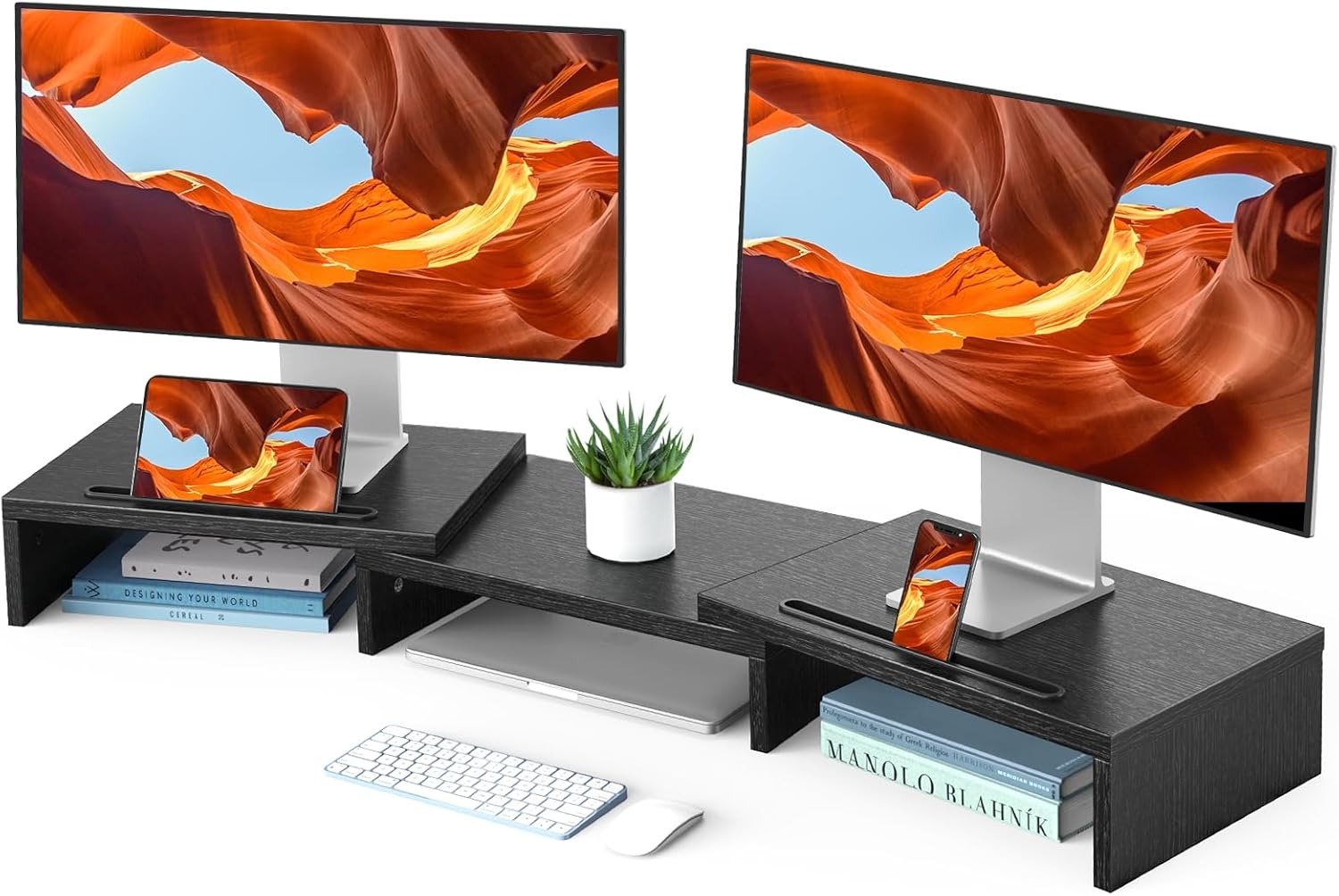
HUANUO Dual Monitor Stand Riser with Adjustable Length and Storage Shelves
If you’re using two monitors (or like flexibility in your layout), this adjustable stand is worth checking out. It features three sections that can be slid together or pulled apart to fit your desk and screen setup.
Key Features:
Adjustable length: Expands from 23.5″ to 36″, making it suitable for single or dual monitor setups.
Open shelf space underneath: Lets you store keyboards, laptops, or books under the riser — keeping your surface tidy.
Sturdy wood and MDF construction: Strong enough to hold multiple monitors or a printer without wobbling.
The adjustable design is useful if you’re still figuring out your ideal screen layout or want to shift things around now and then. It also gives you extra flexibility to store things underneath — from peripherals to decorative touches.
Ideal for multitaskers, remote workers with dual screens, or anyone who likes to customize their setup without committing to a fixed size.
When you’re spending hours a day in front of a screen, screen height matters more than you might think. Most standard desks and laptop stands are too low to keep your screen at eye level. That subtle downward tilt forces your neck to bend forward, shoulders to round, and back muscles to tense up. Over time, this can lead to chronic discomfort, tension headaches, or even long-term posture problems — not exactly the kind of side effects you want from a home office setup.
A monitor riser (also known as a stand or platform) is one of the most straightforward solutions. It raises your screen up by a few inches, helping to bring your line of sight straight ahead — not down. That one adjustment often leads to an instant improvement in how your body feels after a few hours at your desk.
But there’s more to risers than just ergonomics.
🧺 Built-in storage: Many risers include storage compartments, drawers, or shelves underneath. That gives you a spot to stash small things like sticky notes, pens, external drives, or even snacks. It clears the surface clutter without needing bulky organizers, which is especially helpful if you have limited desk space.
🎨 Visual warmth: Unlike industrial office accessories, today’s risers come in cozy or minimalist designs that blend with your space. Whether it’s a bamboo riser that brings in a touch of nature or a matte black one that fits a modern look, this small addition helps your desk feel more like an intentional part of your home — and less like a leftover piece of office furniture.
🧩 Modular options: Some risers are expandable or stackable. If you’re working with dual monitors or switching between a laptop and monitor, you can adjust them to match your setup. That kind of flexibility lets you evolve your workspace over time without starting from scratch.
📐 Bonus perk – more usable space: Once your monitor is raised, the desk surface below it becomes functional. You can slide your keyboard under when you’re not typing, or even create a small decorative zone with a plant, a candle, or a framed photo — something to break up the tech-dominated feel.
In short, a monitor riser is a low-effort, high-impact upgrade. It improves how your body feels at work and how your space looks at a glance. Whether you’re optimizing for comfort, style, or both, it’s a foundational piece worth considering before adding anything else to your desk.
Lift Your View – Monitor Risers that Make a Difference
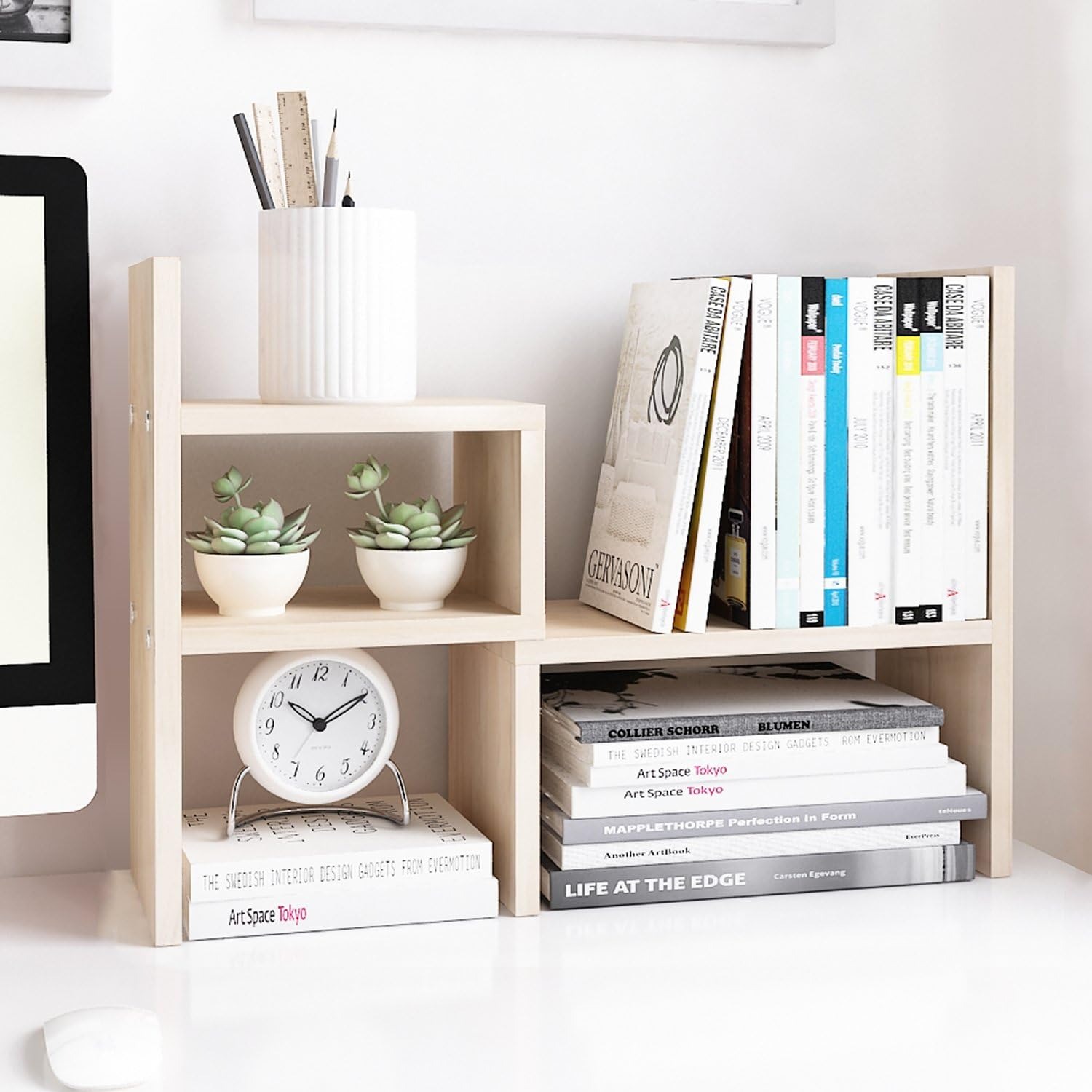
Jerry & Maggie Desktop Organizer – Adjustable Wood Shelf Rack
This modular wood organizer offers a smart way to keep your essentials close at hand without turning your desk into a chaos zone. Made from natural wood (available in light or dark finishes), it instantly adds warmth and structure to any workspace.
Key Features:
Adjustable design: Comes in two separate pieces that you can slide together or apart, creating an L-shape, straight line, or stepped layout depending on your desk space.
Open shelving: Great for storing books, journals, small plants, speakers, or decorative items — not just the boring office stuff.
Compact footprint: Fits nicely on small desks but still gives plenty of room for storage.
It’s a great option if you want something that looks more like a piece of furniture than an “office organizer.” You get storage and style in one, without the bulk of a filing cabinet.
Perfect for anyone trying to build a desk setup that blends into a bedroom or living space, especially if you want to soften the tech look.
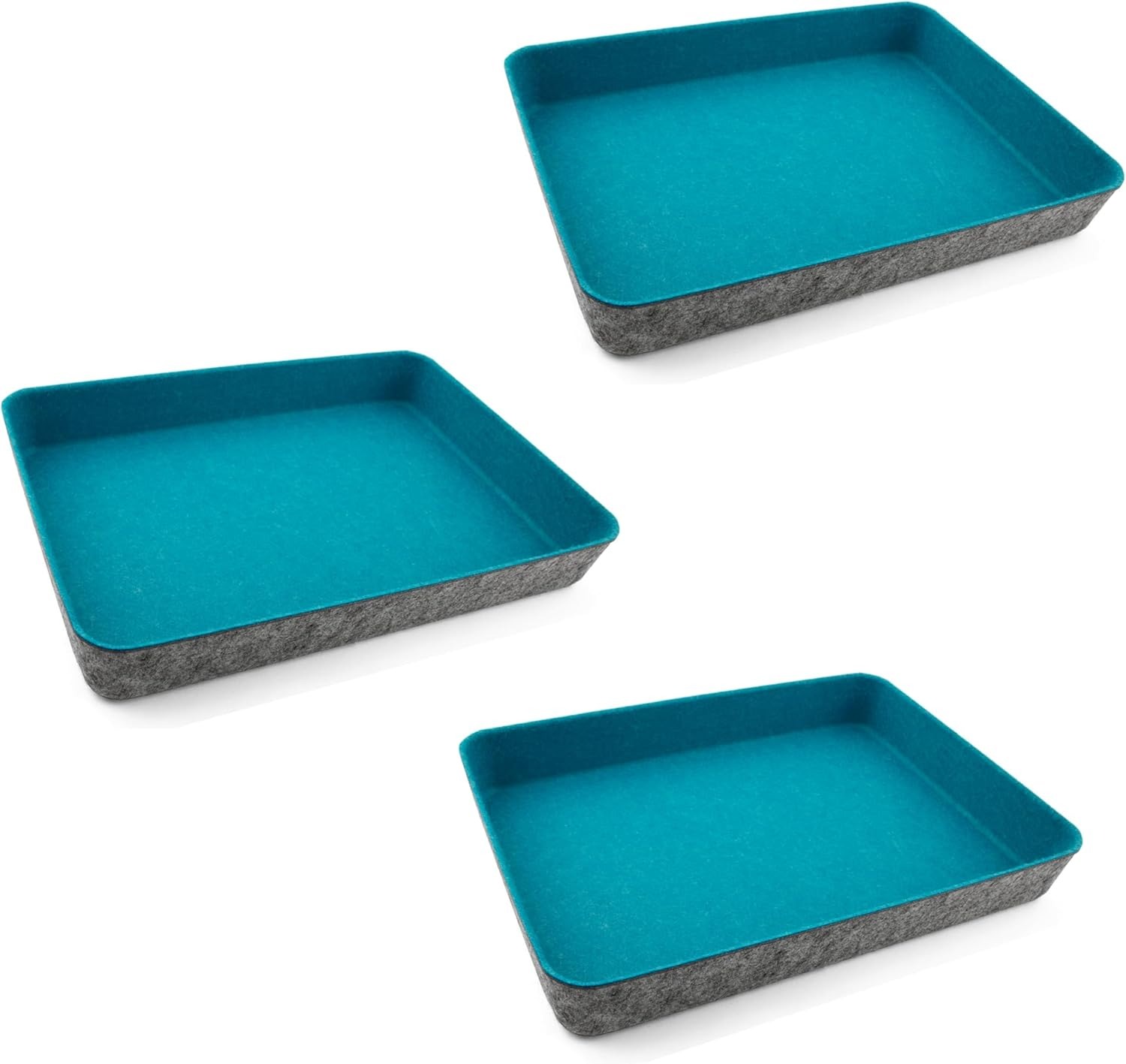
Felt Like It – Wool Felt Desk Organizer Tray Set
This set of soft felt trays is minimal, elegant, and highly useful — especially for people who want to keep their small items organized without creating visual clutter. The trays come in different sizes and nest together when not in use.
Key Features:
Set of three sizes: You get a small, medium, and large tray — perfect for holding earbuds, pens, chargers, or even keys and rings.
Soft-touch material: The wool felt texture adds a warm, tactile element to your desk. It’s subtle, but gives your workspace a more thoughtful, lived-in feel.
Lightweight and portable: Easy to move around or repurpose in drawers or shelves.
Sometimes it’s the little things that make a big difference. These trays help you keep tiny objects from taking over your desk — and unlike hard plastic organizers, they don’t make your space look harsh or cluttered.
Ideal for minimalists, creatives, or anyone who likes a softer, quieter aesthetic in their workspace.
A clean desk can boost your focus and reduce stress — but there’s a fine line between “tidy” and “cold.” If your workspace is filled with sterile plastic bins or clunky drawer units, it might feel more like a supply closet than a place you want to sit down and work. The good news? You can stay organized without making your desk look like a corporate office.
The trick is to combine functionality with visual appeal. That means choosing storage solutions that not only hold your essentials, but also contribute to the overall vibe of your space. Think materials like natural wood, felt, matte metal, or woven textures. These feel softer and more home-like than the usual clear acrylic or gray plastic you find in office supply aisles.
Here’s what to consider when upgrading your desk organization:
🗃️ Go vertical when possible. If you’re short on space, vertical organizers like stacked trays, file racks, or tiered shelves can help you clear off your surface without adding bulk.
📦 Use matching containers. It might sound simple, but using matching or coordinated containers instantly makes things feel more intentional. A few matching fabric boxes or ceramic cups look a lot better than a mix of random mugs, tins, and repurposed jars.
🎨 Choose warm, home-friendly textures. Felt trays, bamboo organizers, soft leather cable holders — these all serve a practical function while adding a cozy visual element to the space.
🔌 Tame the cables. Nothing ruins the look of a space faster than a tangle of wires. Small cord clips, cable boxes, and magnetic ties can make a huge difference — and they don’t have to be ugly.
🧘 Leave some white space. The goal isn’t to fill every corner. Try to leave open areas on your desk surface and shelves. It makes the whole setup feel more breathable and less mentally overwhelming.
Smart storage isn’t about hiding everything. It’s about giving each item a proper place, so your desk feels clear, calm, and a little bit personal — not like a checkout counter.
Next up, we’ll go through two aesthetic storage solutions that strike the right balance between useful and beautiful
Comfort First – Wrist Rests That Actually Feel Good
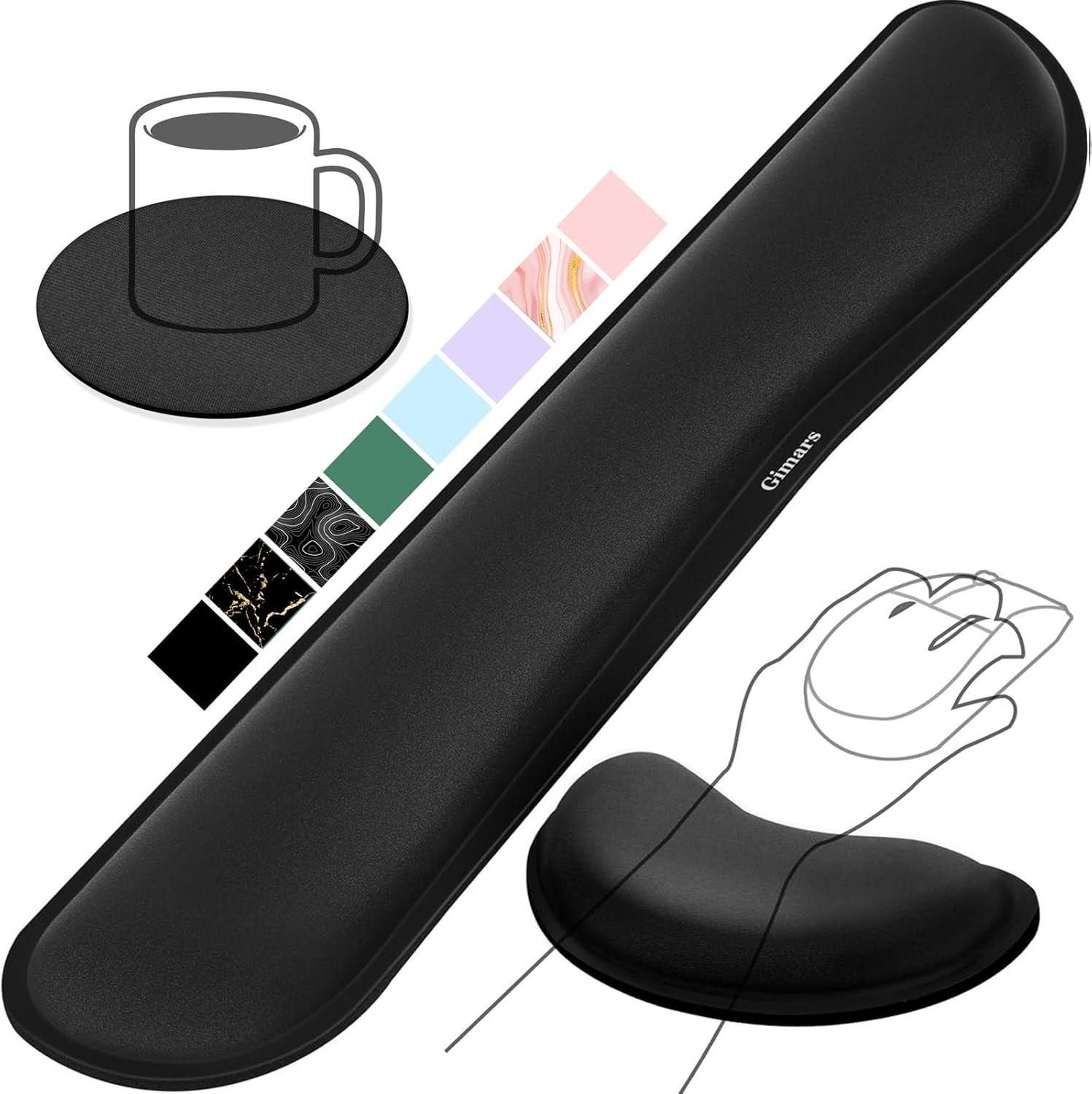
Gimars Memory Foam Wrist Rest Set (Keyboard + Mouse Pad)
If you’re looking for all-day comfort without overthinking the design, this set delivers. It includes both a keyboard wrist rest and a matching mouse pad with built-in wrist support, so you’re covered on both fronts.
Key Features:
Memory foam core: Soft but supportive, the foam molds to your wrist shape without going flat over time.
Non-slip rubber base: Keeps everything in place, even on slick or glassy desk surfaces.
Smooth fabric surface: Works well with any type of mouse — no catching or dragging.
This set is ideal if you’re dealing with wrist fatigue or just want a more comfortable typing experience. The memory foam feels plush without being too squishy, and the mouse pad support is especially helpful if you’re constantly clicking or editing.
Perfect for writers, remote workers, designers, or anyone logging long hours on a keyboard and mouse. It’s practical, subtle, and easy to integrate into any setup.
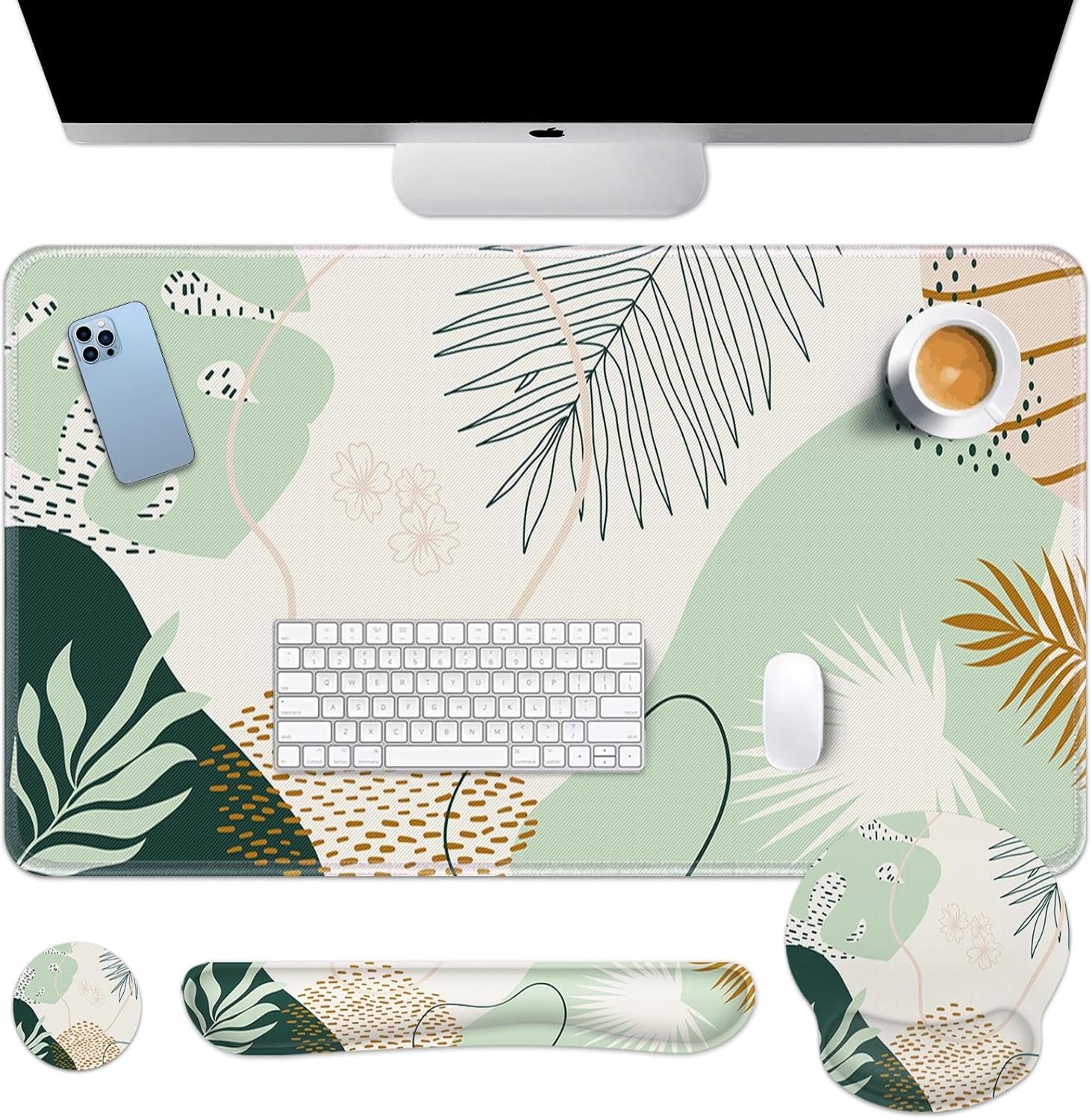
Britimes Keyboard Wrist Rest and Mouse Wrist Pad – Linen Fabric, Non-Toxic Foam
This set offers a slightly more aesthetic and tactile alternative to the typical neoprene or gel wrist rests. The linen-style fabric and neutral tones give it a softer, more homey look — which can really help tone down the “office equipment” vibe.
Key Features:
High-density foam padding: A bit firmer than memory foam, but still very comfortable and durable.
Breathable fabric cover: Feels cooler and drier than synthetic materials, which is especially nice in warm rooms.
Compact and clean design: Doesn’t take up too much desk space or visually overwhelm your layout.
It’s a nice balance of comfort and style. The fabric cover feels more like a soft cushion than a tech accessory, and the neutral design fits well into minimalist or natural-themed setups.
Great for people who want wrist support but also care about the look and feel of their desk — especially those working in spaces that double as personal rooms.
A lot of people don’t think twice about wrist support — until they start to feel the strain. If you spend hours typing or moving a mouse around, even minor tension in your wrists can build up over time. That stiffness or discomfort? It’s your body quietly asking for help. The good news is, you don’t need a bulky, clinical-looking solution to fix it.
Wrist rests offer an easy, low-effort way to support your hands and arms while working. But not all of them are created equal. Some look like they belong in an office from 1998 — thick, plasticky, and out of place in a cozy setup. If you’re going for a workspace that feels calm and personal, it’s worth picking something that works and looks good.
🖐️ Why wrist rests matter:
They help maintain a neutral wrist position, reducing pressure on nerves and tendons.
They relieve muscle fatigue, especially during long typing or editing sessions.
When paired with a mechanical keyboard or a flat desk surface, they improve ergonomics dramatically.
🧵 What to look for:
Materials: Soft memory foam, gel with a cloth cover, or even plush fabric are all comfortable options. Avoid slippery or too-rigid materials — they tend to do more harm than good.
Design: Some wrist rests come in coordinated sets for keyboard and mouse. Others are single pieces with a clean, minimal design.
Aesthetics: Neutral tones, linen textures, or leather accents can help the wrist rest blend into your workspace instead of standing out.
And here’s something people often overlook: a wrist rest isn’t just about support — it’s a subtle comfort cue. When your hands feel supported, it has a ripple effect on how relaxed you are while working. It’s a small change, but it makes your whole desk feel more comfortable and thoughtfully put together.
Next, we’ll go through a couple of wrist rests that are both practical and good-looking — no corporate gray gel blobs in sight.
Light It Right – Decorative Lighting for Mood and Focus
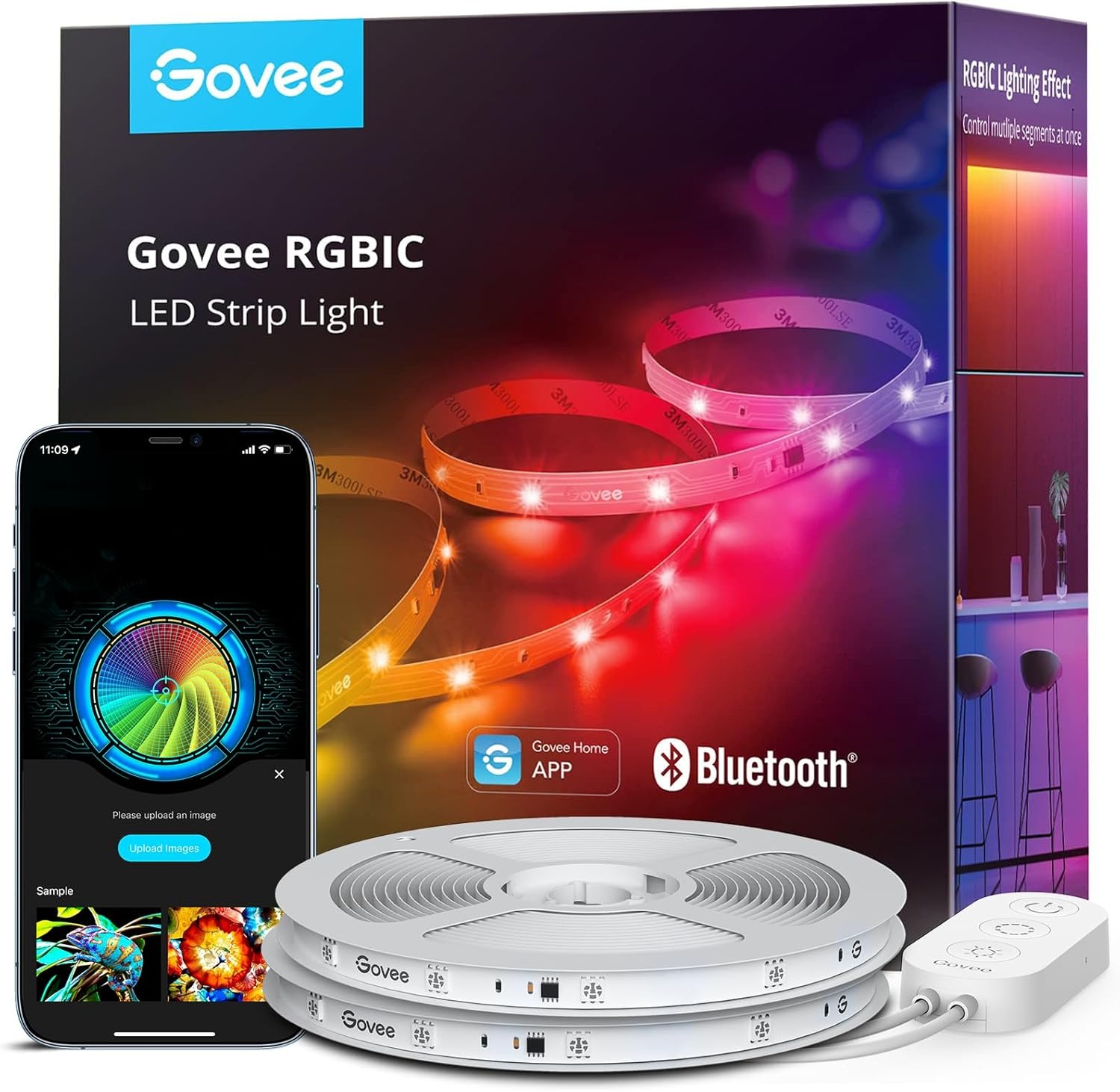
Govee LED Strip Lights with App Control
If you want to create subtle, customizable lighting without adding clutter, this LED strip is a great choice. It sticks to the back of your monitor, desk, or shelves and can be controlled via an app — so you can fine-tune the color and brightness to match your mood or task.
Key Features:
Customizable lighting: Choose from millions of colors or set a soft white glow for focused work.
Adjustable brightness & scheduling: You can dim the lights for evening use or set them to turn on/off automatically.
Easy installation: Adhesive backing makes it simple to stick behind your monitor or under desk edges.
It’s great for adding ambient light without taking up any space. Plus, it helps reduce eye strain during late-night screen use by adding background contrast to your monitor — a small touch that makes long work sessions more comfortable.
Perfect for anyone working in low-light spaces, or for those who want to personalize their desk with color without overdoing it.
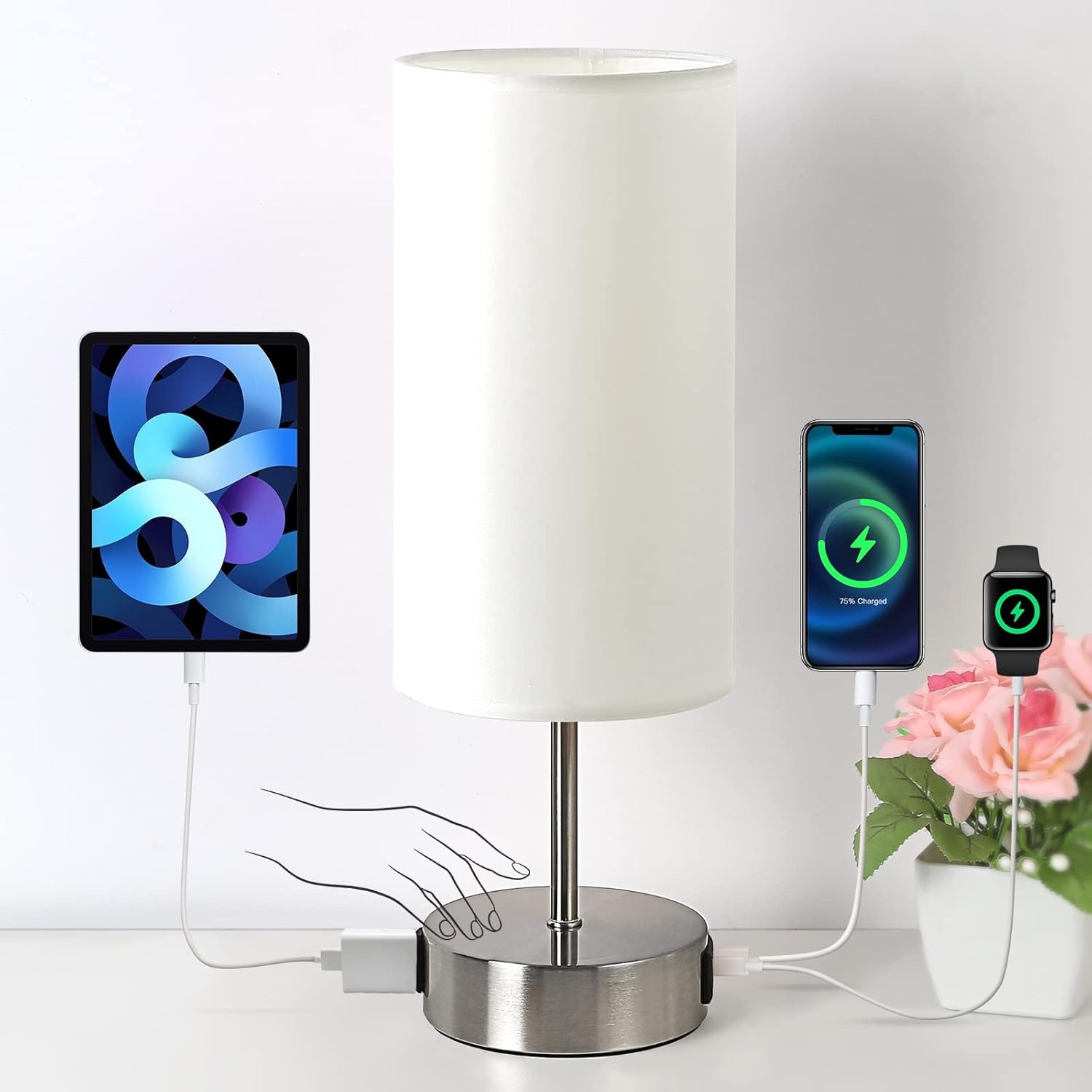
Yarra-Decor Touch Control Bedside Lamp with USB Port
Technically marketed as a bedside lamp, this compact soft-glow light works just as well on a desk — especially if you’re aiming for a cozy, homey setup. Its minimalist linen shade and warm lighting instantly soften the look of a workspace.
Key Features:
Three brightness levels: Tap the base to switch between low, medium, and bright — great for shifting between tasks and relaxation.
Warm, soft light: No harsh glare; easy on the eyes during long hours or early mornings.
Built-in USB port: Charge your phone or wireless earbuds without needing another adapter or outlet.
It brings both style and functionality in one small footprint. The fabric shade gives it a natural, calming presence, and the touch controls are intuitive — no fumbling for switches.
Great for remote workers who want their desk to feel more like a cozy corner than a workstation. Especially good for those working in shared or multi-use spaces like living rooms or bedrooms.
Lighting can completely change how your workspace feels. Harsh overhead lights or cold white LEDs might technically “work,” but they often make your desk feel sterile or overly bright — more like a dentist’s office than a creative, comfortable place to focus.
A smarter approach is to use layered, softer lighting that supports your work and sets a mood you actually enjoy. Whether you’re writing, video calling, or just scrolling, the right light can reduce eye strain, sharpen your focus, and make your desk setup feel more like your space.
Here’s what to keep in mind:
💡 Use more than one source of light. A single overhead light isn’t enough — and it tends to cast harsh shadows. Combine ambient lighting (like a desk lamp or wall light) with accent lighting (such as a light strip or decorative lamp) for a more inviting and balanced feel.
👁️ Choose the right color temperature. For productivity, a warm-neutral white (around 4000K) tends to work best. It’s easier on the eyes than pure daylight white, but not so warm that it makes you sleepy. If you want more flexibility, go for lights with adjustable color settings.
🎨 Add lighting that feels personal. This might be a soft-glow salt lamp, a vintage-style bulb, or even a neon sign that fits your personality. These touches help break the “office” look and make your workspace feel more expressive and relaxing.
🕯️ Light = mood. Brighter, cooler light is great for video calls or focused work. Softer, warmer light is ideal when you’re winding down, journaling, or doing creative tasks. Having both available gives you control over the vibe of your space throughout the day.
🌈 Don’t forget ambient light in the background. If your desk faces a wall, it can feel a little flat or enclosed. Light strips behind your monitor, a small wall sconce, or even a string of LED lights can add visual depth and make the whole area feel more dynamic — especially in the evenings.
Lighting is one of the most affordable ways to upgrade your desk. Even small tweaks can make your space look more inviting, support your eyes and energy, and help you feel more grounded while working. Next, we’ll go over two decorative lighting options that are both functional and aesthetically pleasing.
Bonus Touches – Small Changes, Big Impact
Once you’ve sorted out the essentials — like screen height, storage, wrist support, and lighting — it’s the little extras that truly make a desk setup feel personal and enjoyable. These touches might not be “functional” in the traditional sense, but they can change how you feel at your desk, which matters just as much when you’re working from home.
These aren’t must-haves — but they’re often the difference between a setup that looks good and one that feels good to use every day.
🌿 Add a plant (real or faux): A small succulent, a trailing pothos, or even a well-made faux plant can bring a sense of calm and life to your desk. It’s a visual break from screens and cables — and a simple reminder to breathe.
🖼️ Frame something personal: Whether it’s a photo, a print that makes you smile, or even a page from a notebook you love, having something personal in your eyeline helps your desk feel less generic. It’s your space — let it reflect that.
🎧 Soundscapes or speakers: If you like background noise while working, a compact speaker or white noise machine can help you concentrate and set the tone. Rain sounds? Coffee shop chatter? Lo-fi beats? All fair game.
🕯️ A soft scent: A subtle candle, essential oil diffuser, or incense can make your desk feel more welcoming. Just go light on the scent if you’re sharing your space or working long hours — too much can be distracting instead of relaxing.
📋 Use a mat or desk pad: A felt or leather desk pad defines your workspace visually and adds texture under your keyboard and mouse. It also protects your surface and helps everything feel more “finished.”
🧺 Catch-all trays or bowls: If you tend to accumulate small clutter (USBs, lip balm, hair ties, coins), a single nice-looking tray can keep it all together and still look neat.
The point here isn’t to decorate for decoration’s sake. It’s to create a space that actually feels good to work in — one that reflects your habits, personality, and needs. These small upgrades are usually inexpensive, easy to rearrange, and surprisingly effective at making you want to sit down and get things done.
FAQ
Should I prioritize looks or functionality when upgrading my desk?
Ideally, both — but if you’re starting out, focus on function first. Comfort and efficiency matter most if you’re working long hours. That said, it’s surprisingly easy to find items that do both. Many ergonomic tools now come in aesthetically pleasing designs, so you don’t have to sacrifice one for the other.
What’s the most budget-friendly change I can make that actually helps?
A monitor riser or a desk pad. Both instantly upgrade how your space feels and functions. A riser improves posture and adds storage, while a desk pad defines your space and gives it texture — all without spending much.
Is it worth getting decorative lighting if I already have a ceiling light?
Yes — especially if you’re working early in the morning or into the evening. Overhead lights can be harsh and don’t offer focused or ambient light. A small lamp or LED strip makes the space easier on the eyes and more comfortable to be in for longer stretches.
How do I keep my desk from feeling cluttered after adding all these things?
Use trays, risers with storage, and vertical organizers. And remember: leave some open space. Every item on your desk should have a purpose or bring you joy. If it doesn’t, consider moving it elsewhere. Clutter isn’t about having too much stuff — it’s about not knowing where to put it.
Can I make my desk cozy without a full home office?
Absolutely. Even a corner of a bedroom or shared space can feel inviting with the right lighting, a plant, and a few soft textures. The goal isn’t to build a showroom — it’s to create a space that feels good to sit at, even if it’s small or temporary.
How do I know what to upgrade first?
Ask yourself: What bothers me most right now? Neck strain? Messy surface? Bad lighting? Start there. Tackle one issue at a time. You don’t need a full overhaul — just small steps toward a setup that works better for you.
My desk is in a shared space — how do I make it feel personal without clashing with the room?
Stick to neutral tones and natural textures — think wood, felt, or soft fabrics. Add one or two personal touches like a framed photo or small plant. These elements make the space feel like yours, without standing out too much in a living room or bedroom. You don’t need bold decor to create a sense of ownership.
Is background sound a good idea while working from home?
For many people, yes. A low-volume sound machine or playlist can help reduce distractions and make your desk feel more like a zone. Try soft instrumental music, nature sounds, or ambient noise. Just keep it consistent and not too stimulating — you want something that enhances focus, not competes with it.
Conclusion: Build a Desk Setup That Feels Like Yours
Working from home means your desk isn’t just a place to work — it’s part of your daily life. It’s where you spend hours thinking, creating, solving problems, or just getting through the to-do list. So it should feel good to be there. Comfortable. Calm. And yours.
A functional desk setup doesn’t have to feel cold or impersonal. You don’t need to settle for harsh lights, cheap plastic accessories, or cluttered corners just because it’s “practical.” With a few thoughtful upgrades, you can create a space that’s both efficient and inviting — one that helps you focus without draining your energy.
Here’s what it comes down to:
✅ Lift your screen to eye level — for better posture and a cleaner layout
✅ Organize smarter, using storage that blends in with your personal style
✅ Add comfort where it counts, like wrist rests and soft desk mats
✅ Use lighting intentionally, mixing task lighting with ambient glow for mood and focus
✅ Incorporate personal touches — plants, prints, scents, sound — that make the space feel human, not corporate
You don’t need to do it all at once. Start small. Pick one thing that’s bothering you — maybe your back hurts from a low screen, or your desk feels like a mess — and improve just that. Then build from there.
Remember: this is your space. It should support the way you work, the way you think, and the way you live. Whether you’re in a full home office or a corner of the kitchen, the right setup can make a real difference — not just in productivity, but in how you feel every single day you sit down.
Comfort, clarity, and a bit of personality — that’s what makes a desk setup worth sitting at
